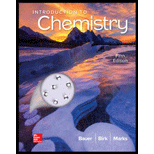
Consider the following reaction:
(a) Which species is oxidized?
(b) Which species is reduced?
(c) What is the oxidizing agent?
(d) What is the reducing agent?
Want to see the full answer?
Check out a sample textbook solution
Chapter 14 Solutions
INTRODUCTION TO CHEMISTRY(LL)-W/CONNECT
- Write balanced net ionic equations for the following reactions in acid solution. (a) Liquid hydrazine reacts with an aqueous solution of sodium bromate. Nitrogen gas and bromide ions are formed. (b) Solid phosphorus (P4) reacts with an aqueous solution of nitrate to form nitrogen oxide gas and dihydrogen phosphate (H2PO4-) ions. (c) Aqueous solutions of potassium sulfite and potassium permanganate react. Sulfate and manganese(II) ions are formed.arrow_forwardOne of the few industrial-scale processes that produce organic compounds electrochemically is used by the Monsanto Company to produce1,4-dicyanobutane. The reduction reaction is 2CH2CHCH+2H++2eNC(CH2)4CN The NC(CH2)4CN is then chemically reduced using hydrogen gas to H2N(CH2)6NH2, which is used in the production of nylon. What current must be used to produce 150.kg NC(CH2)4CN per hour?arrow_forwardTriiodide ions are generated in solution by the following (unbalanced) reaction in acidic solution: IO3(aq) + I(aq) I3(aq) Triiodide ion concentration is determined by titration with a sodium thiosulfate (Na2S2O3) solution. The products are iodide ion and tetrathionate ion (S4O6). a. Balance the equation for the reaction of IO3 with I ions. b. A sample of 0.6013 g of potassium iodate was dissolved in water. Hydrochloric acid and solid potassium iodide were then added. What is the minimum mass of solid KI and the minimum volume of 3.00 M HQ required to convert all of the IO3 ions to I ions? c. Write and balance the equation for the reaction of S2O32 with I3 in acidic solution. d. A 25.00-mL sample of a 0.0100 M solution of KIO. is reacted with an excess of KI. It requires 32.04 mL of Na2S2O3 solution to titrate the I3 ions present. What is the molarity of the Na2S2O3 solution? e. How would you prepare 500.0 mL of the KIO3 solution in part d using solid KIO3?arrow_forward
- 1. If you wish to convert 0.0100 mol of Au3+ (aq) ions into Au(s) in a “gold-plating” process, how long must you electrolyze a solution if the current passing through the circuit is 2.00 amps? 483 seconds 4.83 104 seconds 965 seconds 1450 secondsarrow_forwardThe blood alcohol (C2H5OH) level can be determined by titrating a sample of blood plasma with an acidic potassium di-chromate solution, resulting in the production of Cr3+ (aq) and carbon dioxide. The reaction can be monitored because the dichromate ion (Cr2O72) is orange in solution, and the Cr3+ ion is green. The balanced equations is 16H+(aq) + 2Cr2O72(aq) + C2H5OH(aq) 4Cr4+(aq) + 2CO2(g) + 11H2O(l) This reaction is an oxidationreduction reaction. What species is reduced, and what species is oxidized? How many electrons are transferred in the balanced equation above?arrow_forward1. Sometimes a reaction can fall in more than one category. Into what category (or categories) does the reaction of Ba(OH)2(aq) + H+PO4(aq) fit? acid-base and oxidation-reduction oxidation-reduction acid-base and precipitation precipitationarrow_forward
- Gold can be dissolved from gold-bearing rock by treating the rock with sodium cyanide in the presence of oxygen. 4 Au(s) + 8 NaCN(aq) + O2(g) + 2 H2O() 4 NaAu(CN)2(aq) + 4 NaOH(aq) (a) Name the oxidizing and reducing agents in this reaction. What has been oxidized, and what has been reduced? (b) If you have exactly one metric ton (1 metric ton = 1000 kg) of gold-bearing rock, what volume of 0.075 M NaCN, in liters, do you need to extract the gold if the rock is 0.019% gold?arrow_forwardBromine is obtained from sea water by the following redox reaction: Cl2(g) + 2 NaBr(aq) 2 NaCl(aq) + Br2() (a) What has been oxidized? What has been reduced? (b) Identify the oxidizing and reducing agents.arrow_forwardWrite the net ionic equation and identify the spectator ion or ions in the reaction of nitric acid and magnesium hydroxide. What type of reaction is this? 2 H3O+(aq) + 2 NO3(aq) + Mg(OH)2(s) 4 H2O() + Mg2+(aq) + 2 NO3(aq)arrow_forward
- 2. Equal amounts (moles) of acetic acid(aq) and sodium sulfite, Na2SO3(aq), are mixed. The resulting solution is acidic basic neutralarrow_forwardXenon trioxide, XeO3, reacts with aqueous base to form the xenate anion, HXeO4. This ion reacts further with OH to form the perxenate anion, XeO64, in the following reaction: 2HXeO4(aq)+2OH(aq)XeO64(aq)+Xe(g)+O2(g)+2H2O(l) Identify the elements that are oxidized and reduced in this reaction. You will note that the equation is balanced with respect to the number of atoms on either side. Verify that the redox part of this equation is also balanced, that is, that the extents of oxidation and reduction are also equal.arrow_forwardExperiments show that propionic acid (CH3CH2COOH) is a weak acid. Write the chemical equation.arrow_forward
 Chemistry & Chemical ReactivityChemistryISBN:9781337399074Author:John C. Kotz, Paul M. Treichel, John Townsend, David TreichelPublisher:Cengage Learning
Chemistry & Chemical ReactivityChemistryISBN:9781337399074Author:John C. Kotz, Paul M. Treichel, John Townsend, David TreichelPublisher:Cengage Learning Chemistry & Chemical ReactivityChemistryISBN:9781133949640Author:John C. Kotz, Paul M. Treichel, John Townsend, David TreichelPublisher:Cengage Learning
Chemistry & Chemical ReactivityChemistryISBN:9781133949640Author:John C. Kotz, Paul M. Treichel, John Townsend, David TreichelPublisher:Cengage Learning ChemistryChemistryISBN:9781305957404Author:Steven S. Zumdahl, Susan A. Zumdahl, Donald J. DeCostePublisher:Cengage Learning
ChemistryChemistryISBN:9781305957404Author:Steven S. Zumdahl, Susan A. Zumdahl, Donald J. DeCostePublisher:Cengage Learning- Chemistry: Matter and ChangeChemistryISBN:9780078746376Author:Dinah Zike, Laurel Dingrando, Nicholas Hainen, Cheryl WistromPublisher:Glencoe/McGraw-Hill School Pub Co
 Chemistry: The Molecular ScienceChemistryISBN:9781285199047Author:John W. Moore, Conrad L. StanitskiPublisher:Cengage Learning
Chemistry: The Molecular ScienceChemistryISBN:9781285199047Author:John W. Moore, Conrad L. StanitskiPublisher:Cengage Learning Chemistry: Principles and PracticeChemistryISBN:9780534420123Author:Daniel L. Reger, Scott R. Goode, David W. Ball, Edward MercerPublisher:Cengage Learning
Chemistry: Principles and PracticeChemistryISBN:9780534420123Author:Daniel L. Reger, Scott R. Goode, David W. Ball, Edward MercerPublisher:Cengage Learning





